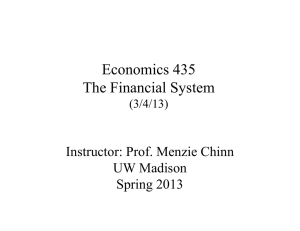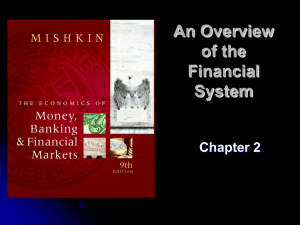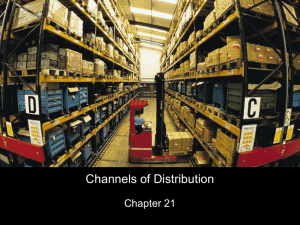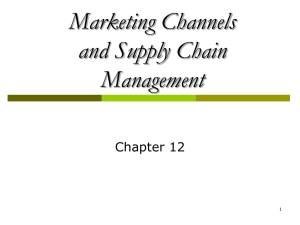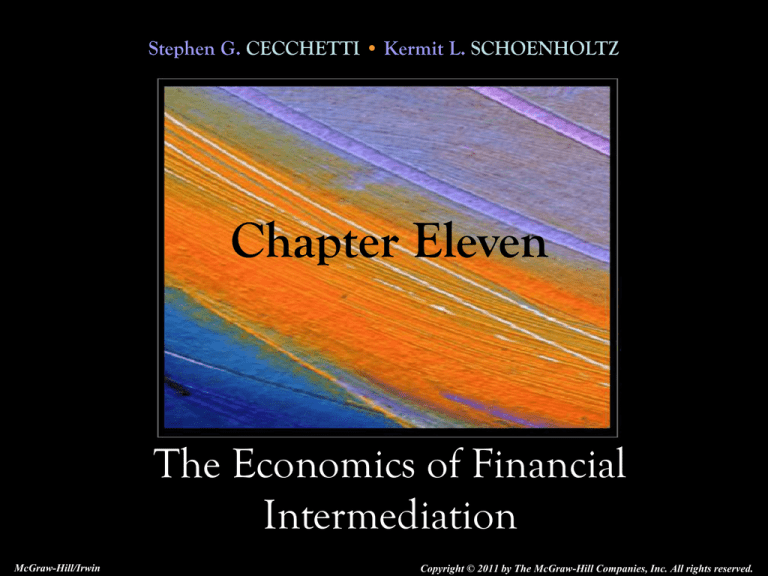
Stephen G. CECCHETTI • Kermit L. SCHOENHOLTZ
Chapter Eleven
The Economics of Financial
Intermediation
McGraw-Hill/Irwin
Copyright © 2011 by The McGraw-Hill Companies, Inc. All rights reserved.
Introduction
• In Part III we will be focusing on financial
institutions and government regulatory
agencies.
• In this chapter we will examine financial
institutions’ purpose -- financial
intermediation.
11-2
Introduction
• Financial institutions serve as intermediaries
between savers and borrowers, so their assets
and liabilities are primarily financial
instruments.
• These institutions pool funds from people and
firms who save and lend them to people and
firms who need to borrow.
• This transforms assets and provides access to
financial markets.
11-3
Introduction
• Intermediaries investigate the financial
condition of the individuals and firms who
want financing to figure out which have the
best investment opportunities.
• Intermediaries increase investment and
economic growth at the same time that they
reduce investment risk and economic volatility.
11-4
Introduction
• Without a stable, smoothly functioning
financial system, no country can prosper.
• Figure 11.1 plots a commonly used measure of
financial activity--the ratio of credit extended
to the private sector and to gross domestic
product--against real GDP per capita.
• We can see that there are not any rich countries
with very low levels of financial development.
11-5
Introduction
11-6
Introduction
• The flow of information among parties in a
market system is particularly rife with
problems.
• These problems can derail real growth unless
they are addressed properly.
• In this chapter we will discuss some of these
information problems and learn how financial
intermediaries attempt to solve them.
11-7
The Role of Financial Intermediaries
• Financial markets are important because they
price economic resources and allocate them to
their most productive uses.
• Intermediaries, including banks and securities
firms, continue to play a key role in both direct
and indirect finance.
• Table 11.1 illustrates the importance of direct
and indirect finance.
11-8
The Role of Financial Intermediaries
11-9
The Role of Financial Intermediaries
• From the table we can see:
• To make comparisons across countries of vastly
different size, we measure everything relative to
GDP.
• There is no reason that the value of a country's
stock market, bonds outstanding, or bank loans
cannot be bigger than its GDP.
• When you add up all the types of financing,
direct and indirect, as a percentage of GDP, the
numbers will generally sum to more than 100
in an advanced economy.
11-10
The Role of Financial Intermediaries
• These data highlight the importance of
intermediaries.
• Banks are still critical providers of financing around
the world.
• Intermediaries determine which firms can access
the stock and bond markets.
• Banks decide the size of a loan and interest rate to
be charged.
• Securities firms set the volume and price of new
stocks and bond issues when they purchase them for
sale to investors.
11-11
The Role of Financial Intermediaries
• Financial intermediaries are important because
of information.
• Lending and borrowing involves both
transactions costs and information costs.
• Financial institutions exist to reduce these
costs.
11-12
The Role of Financial Intermediaries
In their role as financial intermediaries, financial
institutions perform five functions:
1. Pooling the resources of small savers,
2. Providing safekeeping and accounting services, as
well as access to payments system,
3. Supplying liquidity by converting savers’ balances
directly into a means of payment whenever
needed,
4. Providing ways to diversify risk, and
5. Collecting and processing information in ways
that reduce information costs.
11-13
Pooling Savings
• The most straightforward economic function of
a financial intermediary is to pool the resources
of many small savers.
• By accepting many small deposits, banks empower
themselves to make large loans.
• In order to do this, the intermediary:
• Must attract substantial numbers of savers, and
• Must convince potential depositors of the
institution’s soundness.
11-14
Safekeeping, Payments System Access,
and Accounting
• Banks:
• Are a place for safekeeping.
• Provide access to the payments system -- the
network that transfers funds from the account of
one person or business to the account of another.
• Specialize in handing payments transactions,
allowing them to offer these services relatively
cheaply.
11-15
Safekeeping, Payments System Access,
and Accounting
• By giving us a way to pay for things, financial
intermediaries facilitate the exchange of goods
and services.
• This principal of comparative advantage leads
to specialization so that each of us ends up
doing just one job and being paid in some form
of money.
• Financial intermediaries, by providing us with
a reliable and inexpensive payments system,
help our economy to function more efficiently.
11-16
Safekeeping, Payments System Access,
and Accounting
• Financial intermediaries also help us manage
our finances.
• They provide us with bookkeeping and
accounting services, noting all our transactions
for us and making our lives more tolerable in
the process.
• These force financial intermediaries to write
legal contracts - but one can be written and
used over and over again - reducing the cost of
each.
11-17
Safekeeping, Payments System Access,
and Accounting
• Much of what financial intermediaries do takes
advantage of economies of scale, in which the
average cost of producing a good or service
falls as the quantity produced increases.
11-18
Providing Liquidity
• Liquidity is a measure of the ease and cost with
which an asset can be turned into a means of
payment.
• Financial intermediaries offer us the ability to
transform assets into money at relatively low
cost - ATM’s, for example.
• Banks can structure their assets accordingly,
keeping enough funds in short-term, liquid
financial instruments to satisfy the few people
who will need them and lending out the rest.
11-19
Providing Liquidity
• By collecting funds from a large number of
small investors, the bank can reduce the cost of
their combined investment, offering each
individual investor both liquidity and high rates
of return.
• Intermediaries offer both individuals and
businesses lines of credit, which provides
customers with access to liquidity.
11-20
Providing Liquidity
• A financial intermediary must specialize in
liquidity management.
• It must design its balance sheet so that it can
sustain sudden withdrawals.
11-21
• As a student, you usually have no credit
history.
• A credit card company will assume the worst.
• Issuers charge high interest rates as
compensation for the risk they are taking.
• Remember that with a high interest rate,
borrowing is very expensive.
11-22
Diversifying Risk
• Financial institutions enable us to diversify our
investments and reduce risk.
• Banks take deposits from thousands of
individuals and make thousands of loans with
them.
• Each depositor has a very small stake in each one of
the loans.
• All financial intermediaries provide a low-cost
way for individuals to diversify their
investments.
11-23
Collecting and Processing Information
• The fact that the borrower knows whether he or
she is trustworthy, while the lender faces
substantial costs to obtain that information,
results in an information asymmetry.
• Borrowers have information that lenders don’t.
• By collecting and processing standardized
information, financial intermediaries reduce the
problems that information asymmetries create.
11-24
Information Asymmetries
and Information Costs
• Information plays a central role in the structure
of financial markets and financial institutions.
• Markets require sophisticated information to
work well.
• If the cost of information is too high, markets cease
to function.
• Issuers of financial instruments know more
about their business prospects and willingness
to work than potential lenders/investors.
11-25
Information Asymmetries
and Information Costs
•
Asymmetric information is a serious hindrance
to the operation of financial markets.
• It poses two important obstacles to the smooth
flow of funds from savers to investors:
1. Adverse selection arises before the transaction
occurs.
•
Lenders need to know how to distinguish good credit
risks from bad.
2. Moral hazard occurs after the transaction.
•
Will borrowers use the money as they claim?
11-26
• The Madoff scandal was a classic Ponzi scheme:
• Fraud in which an intermediary collects funds from new
investors, but instead of investing them, uses the funds to pay
off earlier investors.
• Investors fail to screen and monitor the managers who
receive their funds.
• A façade of public respectability contributes to the
success of a Ponzi scheme, and Madoff was a master at
burnishing his reputation.
• Everyone acted as if someone else was monitoring, so
they could enjoy the free ride.
11-27
Adverse Selection
• The market for lemons:
• Used car buyers can’t tell good from bad cars.
• Buyers will at most pay the expected value of good
and bad cars.
• Sellers know if they have a good car, and won’t
accept less than the true value.
• Good car sellers will withdraw cars from the
market.
• Then the market has only the bad cars.
11-28
Adverse Selection in Financial Markets
• If you can’t tell good from bad companies
• Stocks of good companies are undervalued, and
• Owners will not want to sell them.
• If you can’t tell good from bad bonds
• Owners of good companies will have to sell bonds
for too low a price, so
• Owners won’t want to do it.
11-29
Solving the Adverse Selection Problem
• From a social perspective, the problems of
adverse selection are not good.
• Some companies will pass up good investments.
• Economy will not grow as rapidly as it could.
• We must find ways for investors and lenders to
distinguish well-run firms from poorly run
firms.
11-30
• If you try to buy a house with a down payment
of less than 20 percent of the purchase price,
the lender may require you to buy private
mortgage insurance (PMI).
• PMI insures the lender in the event that the
borrower defaults on the mortgage.
• You can cancel the insurance when your loan
principal is less than 80 percent of the value.
11-31
Disclosure of Information
• An obvious way to solve the problem of
asymmetric information is to provide more
information.
• In most industrialized countries, public
companies are required to disclose voluminous
amounts of information.
• Public companies are those that issue stock and
bonds that are bought and sold in pubic financial
markets.
11-32
Disclosure of Information
• For example, in the U.S., the Securities and
Exchange Commission (SEC) requires firms to
produce public financial statements that are
prepared according to standard accounting
practices.
• However, with the help of some unethical
accountants, company executives found a
broad range of ways to manipulate the
statements to disguise their firms’ true financial
condition.
11-33
Disclosure of Information
• Although accounting practices have changed,
information problems persist.
• In a limited sense there is private information
collected and sold to investors.
• Research services like Moody’s, Value Line, and
Dun and Bradstreet collect information directly
from firms and produce evaluations.
• To be credible, companies cannot pay for this
research, so investors have to.
11-34
Disclosure of Information
• Private information services face a free-rider
problem.
• A free-rider is someone who doesn’t pay the cost to
get the benefit of a good or service.
• The publications are expensive, but public
libraries subscribe to them and writers for
periodicals read them and write stories
publicizing crucial information.
11-35
• Deflation is harmful because it aggravates
information problems in ways that inflation
does not - it reduces a company’s net worth.
• When prices fall,
• The dollar value of the firm’s liabilities remains the
same, but
• The value of the firm’s assets fall with the price
level.
• Deflation drives down a firm’s net worth,
making it less trustworthy as a borrower.
11-36
Collateral and Net Worth
• Another solution for adverse selection is to
make sure lenders are compensated even if
borrowers default.
• If a loan is insured in some way, then the borrower
isn’t a bad credit risk.
• Collateral is something of value pledged by a
borrower to the lender in the event of the
borrower’s default.
• It is said to back or secure a loan.
• Ex: Cars, houses
11-37
Collateral and Net Worth
• Collateral is very prevalent because adverse
selection is less of a concern - the lender gets
something of equal or greater value if the
borrower defaults.
• Unsecured loans, like credit cards, are loans
made without collateral.
• Because of this they generally have very high
interest rates.
11-38
Collateral and Net Worth
• The net worth is the owner’s stake in a firm the value of the firm’s assets minus the value
of its liabilities.
• Net worth serves the same purpose as collateral
• If a firm defaults on a loan, the lender can make a
claim against the firm’s net worth.
• From the perspective of the mortgage lender,
the homeowner’s equity serves exactly the
same function as net worth in a business loan.
11-39
Collateral and Net Worth
• The importance of net worth in reducing
adverse selection is the reason owners of new
businesses have so much difficulty borrowing
money.
• Most small business owners must put up their
homes and other property as collateral for their
business loans.
• Only after establishing a successful business and
built up net worth, can they borrow without
personal property.
11-40
Moral Hazard: Problem and Solutions
• The phrase moral hazard originated when
economists who were studying insurance noted
that an insurance policy changes the behavior
of the person who is insured.
• Moral hazard arises when we cannot observe
people’s actions and therefore cannot judge
whether a poor outcome was intentional or just
a result of bad luck.
11-41
Moral Hazard: Problem and Solutions
• A second information asymmetry arises
because the borrower knows more than the
lender about the way borrowed funds will be
used and the effort that will go into a project.
• Moral hazard affects both equity and bond
financing.
• How do we solve the problem?
11-42
Moral Hazard in Equity Finance
• If you buy stock in a company, how do you
know your money will be used in the way that
is best for you, the stockholder?
• It is more likely that the manager will use the
funds in a way that is most advantageous to
them, not you.
• The separation of your ownership from their
control creates what is called a principal-agent
problem.
11-43
Solving the Moral Hazard Problem in
Equity Financing
• During the 1990’s, a concerted attempt was
made to align managers’ interests with those of
stockholders.
• Executives were given stock options that provided
lucrative payoffs if a firm’s stock price rose above a
certain level.
• This gave managers incentives to misrepresent
companies’ profits.
• At this time, there is no foolproof way of
ensuring managers will behave in the owner’s
best interest.
11-44
Moral Hazard in Debt Finance
• When the managers are the owners, moral
hazard in equity finance disappears.
• Because debt contracts allow owners to keep
all the profits in excess of the loan payments,
they encourage risk taking.
• Lenders need to find ways to make sure
borrowers don’t take too many risks.
• People with risky projects are attracted to debt
finance because they get the full benefit of the
upside, while the downside is limited to their
collateral.
11-45
Solving the Moral Hazard Problem in
Debt Finance
• Legal contracts can solve the moral hazard
problem inherent in debt finance.
• Bonds and loans carry restrictive covenants that
limit the amount of risk a borrower can assume.
• The firm may have to maintain a certain level of net
worth, a minimum credit rating, or a minimum bank
balance.
• For example: home mortgages’ home insurance, fire
insurance, etc.
11-46
Negative Consequences of
Information Costs
11-47
• A key source of the financial crisis of 20072009 was insufficient screening and monitoring
in the securitization of mortgages.
• Originators eased standards and reduced
screening to increase volume and short-term
profitability.
• The firms that assembled the mortgages for
sale, the distributors, could have required
originators to demonstrate a high level of net
worth.
11-48
• When lending standards decline, securitization
becomes a game of “hot-potato”.
• The game ends when defaults soar and
someone is left with the loss.
• Ratings agencies could have halted the game
early, but instead gave their highest ratings to a
large share of mortgage-backed securities.
• Many investors and government officials
assumed agencies’ ratings were accurate - they
were free riders.
11-49
Financial Intermediaries and
Information Costs
• Much of the information that financial
intermediaries collect is used to:
• Reduce information costs, and
• Minimize the effects of adverse selection and moral
hazard.
• To do this, intermediaries:
• Screen loan applicants,
• Monitor borrowers, and
• Penalize borrowers by enforcing contracts.
11-50
Screening and Certifying to Reduce
Adverse Selection
• The lender uses the number to identify you to a
company that collects and analyzes credit
information, summarizing it for potential
lenders in a credit score.
• Every time someone requests a credit score,
they have to pay, eliminating the free rider
problem.
• Banks can collect information on a borrower
that goes beyond their credit report and loan
application.
11-51
Screening and Certifying to Reduce
Adverse Selection
• Underwriters screen and certify firms seeking
to raise funds directly in the financial markets.
• Underwriters are large investment banks like
Goldman Sachs, JPMorgan Chase, and Morgan
Stanley.
• Without certification by one of these firms,
companies would find it difficult to raise funds.
11-52
Monitoring to Reduce Moral Hazard
• In the financial world, intermediaries insure
against this type of moral hazard by monitoring
both the firms that issue bonds and those that
issue stocks.
• Many hold significant number of shares in
individual firms.
• They may place a representative on the company’s
board of directors.
11-53
Monitoring to Reduce Moral Hazard
• For new companies, a financial intermediary
called a venture capital firm does the
monitoring.
• They specialize in investing in risky new ventures
in return for a stake in the ownership and a share of
the profits.
• They keep a close watch on the managers’ actions.
• Finally, the threat of a takeover helps to
persuade managers to act in the interest of the
stock and bondholders.
11-54
How Companies Finance Growth and
Investment
•
We noted two things at the beginning of this
chapter:
1. Wealthy countries have high levels of financial
development, and
2. Intermediaries play key roles both in direct and
indirect finance.
•
In addition to direct and indirect finance, a
firm can also use its own profits.
11-55
How Companies Finance Growth and
Investment
• Instead of distributing profits to shareholders, a
firm can reinvest the earnings into the firm.
• A vast majority of investment financing comes from
internal sources.
• The fact that managers have superior
information about the way in which their firms
are and should be run makes internal finance
the rational choice.
11-56
How Companies Finance Growth and
Investment
11-57
• Due to the tightening of financial markets, a
number of peer-to-peer borrowing websites
have popped up.
• They are depending on credit scores, debt
ratios, and other factors to determine to whom
to lend money.
• Is this more efficient and cheaper than a bank?
• Will these peer-to-peer organizations replace
financial intermediaries?
11-58
Stephen G. CECCHETTI • Kermit L. SCHOENHOLTZ
End of
Chapter Eleven
The Economics of Financial
Intermediation
McGraw-Hill/Irwin
Copyright © 2011 by The McGraw-Hill Companies, Inc. All rights reserved.


